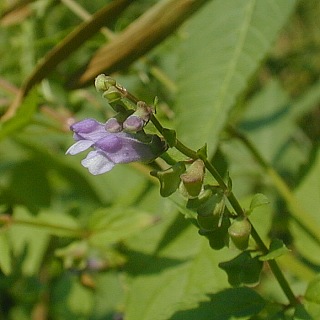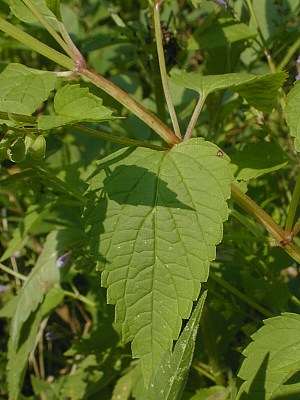Description: This perennial plant is 1–2½' tall, branching occasionally. The stems are light green to pale reddish-green, 4-angled, and hairless or sparsely canescent; they have a tendency to sprawl. The blades of the opposite leaves are up to 3" long and 2" across; they are cordate-ovate to broadly lanceolate, hairless, and coarsely serrated along the margins. On the upper surface of each leaf blade, there is a conspicuous network of veins. The petioles of the leaves are light green to pale reddish green, slender, and up to 1" long. Both terminal and axillary racemes of flowers are produced by the upper stems. Each slender raceme is up to 6" long, consisting of about 6-7 pairs of flowers; the axillary racemes spread outward from their stems. Underneath each flower, there is a short leafy bract.

Each
flower is up to 1/3" (8 mm.) in length, consisting of a tubular corolla
and a
tubular calyx. The corolla is pale blue, lavender, or white; it has
short upper and lower lips. The lower is lip is often white, while the
upper lip is often a slightly darker color. The calyx is light green or
pale reddish green, hairless or sparsely canescent, and divided into 2
shallow lobes. Behind the upper lobe is a short dish-like projection
that is typical of Scutellaria spp. (Skullcaps).
The pedicel of each flower is slender and short. The blooming period
occurs during the summer and early fall, lasting about 1½–2 months for
a colony of plants. Usually, only a few flowers are in bloom at the
same time in a raceme. There is no noticeable floral scent. Each flower
is replaced by an oddly-shaped seed capsule that contains 4 nutlets.
This capsule consists of 2 lobes that are joined at the base, but
spread slightly apart from each other at their tips; these lobes are
somewhat flattened and round along their margins. The root system
consists of a taproot and either rhizomes or stolons. Small colonies of
plants are often produced from the rhizomes or stolons.
Cultivation:
The preference is light shade to full sun, wet to moist conditions, and
soil with abundant organic matter. Shallow rocky or gravelly soil is
tolerated if it retains moisture during dry spells.

Range & Habitat:
The native Mad-Dog Skullcap is occasional to locally common in central
and
northern Illinois; in the southern portion of the state, it is usually
less common (see Distribution
Map). Habitats include moist sedge meadows, openings in
floodplain woodlands, soggy thickets, swamps, bogs, seeps and springs,
edges
of vernal pools and ponds, moist depressions in limestone glades, and
shaded areas of cliffs. In wooded areas, this plant benefits from any
disturbance that reduces the density of woody vegetation; it is
typically found in partially shaded wetland areas.
Faunal Associations:
The flowers attract few insect visitors; however, Robertson (1929)
observed a long-tongued bee, Melissodes bimaculata bimaculata,
sucking nectar from them. The caterpillars of Prochoreutis
inflatella (Chorentid Moth sp.) skeletonize the leaves of
Mad-Dog Skullcap. Mammalian herbivores and geese won't eat the foliage
of this plant because of its bitter taste and mildly toxic properties.
The Ring-Necked Pheasant reportedly eats the seeds.
Photographic Location:
At the edge of a powerline clearance in Busey Woods, Urbana, Illinois,
where several plants were growing in a sedge meadow. This plant also
grows along the edge of Crystal Lake in the same area.
Comments:
This is probably the most common Scutellaria sp.
(Skullcap) in central and northern Illinois. Mad-Dog Skullcap is fairly
easy to identify because it has the smallest flowers in this genus (up
to 1/3" long) and it produces abundant axillary racemes. Other
Skullcaps have larger flowers that they produce in pairs along the
stems, or in terminal racemes only (for the most part). The Skullcaps
can be distinguished from other members of the Mint family by their
oddly-shaped calyxes and seedpods (see the descriptions above). In some
species, the lobes of the seedpods have a concave surface that
resembles the inside of a skullcap, hence the common name for species
in this genus. At one time, there was a belief that Mad-Dog Skullcap
could cure rabies, which is false. However, the foliage contains a
substance with anti-spasmodic and sedative properties, so it does have
some medicinal value.